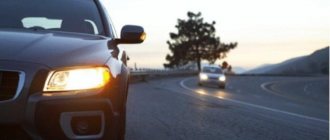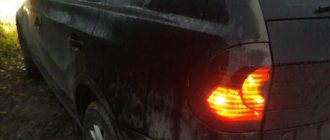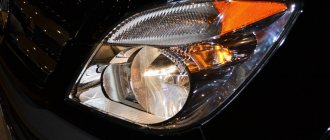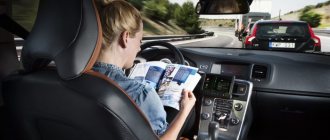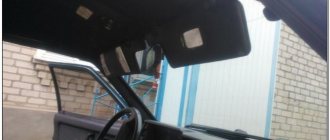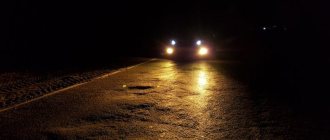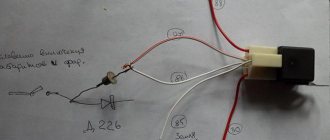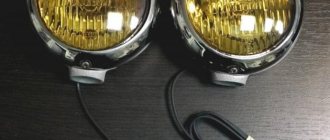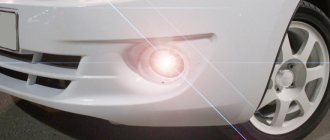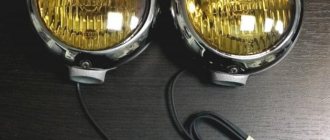A modern car has as many as 8 different lighting devices installed (there is also a backlight for the rear license plate, but in this case we are not interested in it). And we need to use these 7 lighting devices: headlights, flashlights, foglights and other things in different ways, depending on as many as 8 conditions. Let's list lighting devices and conditions for their use for 2022!
So, the car has so-called external lighting devices. These include:
- headlights: low beam;
- headlights: high beam;
- rear lights;
- fog lights (PTF);
- rear fog lights;
- parking lights;
- daytime running lights (DRLs).
And among the conditions for including certain lighting devices in the traffic rules, there are the following:
- daylight hours;
- dark time of day: illuminated road;
- dark time of day: unlit road;
- low visibility conditions;
- standing/moving car;
- trailer/towed vehicle;
- populated/non-populated area.
Are you scared? It's actually not all that scary. Let's find out when and in what cases you need to turn on the headlights, fog lights, high or low beam headlights and dimensions. Data current as of September 6, 2022. For convenience, we will consider the rules for using car lights depending on the time of day and other conditions, and answer some pressing questions. And at the end of the article we will provide a table as a simple way to remember when which lights need to be turned on on the car.
Traffic rules and fog lights - the main subtlety
First, let’s clarify the main point regarding the requirements of the Road Traffic Rules for the use of PTF.
The fact is that the Rules do not prohibit or oblige the inclusion of fog lights in 2022 at all. Traffic regulations only indicate in what cases these lights can be used. And they do not directly prohibit their inclusion in other, not listed cases. This leads to a twofold situation when traffic police officers or courts considering the case can interpret these cases as a ban on using PTF. However, we have what we have - if the Rules indicate the possibility of their use, but do not prescribe when it is prohibited, it means that in other situations it is not prohibited. However, keep in mind that in practice you may encounter such an interpretation by traffic police officers, when traffic rules allegedly prohibit something that is not expressly permitted.
In order to better understand what we are talking about, let's consider, in fact, all such cases when traffic regulations allow the use of fog lights. And also how exactly it is spelled out in them.
Design difference
Fog lights are usually located at the bottom of the bumper. Why? The fact is that usually the fog spreads no lower than half a meter from the road. Thus, the fog lights are better visible to other drivers. At the same time, they provide visibility at a distance of about 30 m in front of the car. The beam of light from the fog lights is as wide as possible and tilted slightly downwards. Two fog lights provide a very wide illuminated sector at a short distance from the vehicle. And the main beam consists of two concentrated narrow beams, due to which illumination is provided at a distance of approximately 100 m. But the roadsides near the car are practically not illuminated by the main beam.
What happens if you turn on your high beams in fog? You won't get anything good. The high beam source is usually located higher than the fog lights. Turn on the high beam and a white, opaque wall will appear in front of the car. Thousands of microdroplets of water, which make up the fog, will reflect the light of the headlights. Low beam in the same conditions will allow you to see at least something. Why? Yes, because the luminous flux of the low beam is directed slightly lower.
When can I use PTF in 2022?
So, the answer to this question is almost entirely governed by Section 19 of the Rules of the Road, directly or contextually in paragraphs 19.3, 19.4, 19.5 and 19.7.
Therefore, you have the right:
- use fog lights in conditions of poor visibility (in rain, fog, snowfall, etc.), but only in conjunction with low or high beam (when not prohibited) beams,
- in the dark under two conditions: you are moving along an unlit section of the road, and you also have the low beam or high beam switched on,
- during daylight hours, you can turn on the PTF instead of the low beam to indicate the vehicle in accordance with clause 19.5 of the traffic rules,
- when stopping or parking on an unlit road in the dark or in conditions of insufficient visibility, together with the dimensions.
For further understanding, let’s look at one term in the Rules. Insufficient visibility is visibility less than 300 meters due to fog, snow or rain. But traffic rules also include twilight in these conditions.
So this is what we wrote about above. Traffic regulations indicate the possibility of using fog lights on a car in this way:
19.4. Fog lights can be used:…
And here a certain double situation is created. And, as a rule, this expression is explained by two different “expert” opinions:
- section 19 of the traffic rules describes when you have the right to turn on the fog lights; and this automatically means that in other cases their use is prohibited (for example, on a section of road with street lighting at night),
- the expression “can be used” was written taking into account the fact that not all cars have PTFs, and in principle they are not required to be installed by manufacturers, according to the requirements of the Technical Regulations.
Which of these “camps” to choose specifically in your case is up to you to decide. If you do not want to appeal a fine for violating the rules for using fog lights, then it is better to adhere to the first interpretation. If for you the letter of the normative act is the law, then choose the second option.
You will also be interested in:
- Is it possible to install a chandelier headlight on the roof of a car and make it legal? What's the fine?
- All about the fine for low beam: what size is it if the headlights are not turned on or do not work?
- Is it possible to install and drive with illumination of the underbody of the car and what is the fine?
During the day
If with the dark time of the day everything is extremely clear, then with the daytime it is a little more complicated. Based on the list above, we will list when you can use these lights during daylight hours.
- If you are caught in fog, rain, snowfall or similar circumstances (twilight, smog, etc.), provided that visibility of the road ahead is less than 300 meters.
- If you use your fog lights as daytime running lights.
Please note an important subtlety - during the day, to identify your car, you have the right to turn on PTF exclusively instead of low beam headlights according to the letter of the traffic rules (clause 19.4). If your DRLs automatically turn on when the low beam is turned off, then formally you cannot use fog lights together with it (including, technically, you cannot turn them on when the low beam is turned off). Only the option of side lights plus PTF is possible.
Internal elements of the lighting system
Internal elements are responsible for lighting in the interior and trunk of the vehicle. The system includes:
- lamps in the car interior;
- trunk lighting;
- dashboard lighting lamps;
- glove box lamp;
- side lights in the doors.
Lighting of the interior, trunk and space under the hood (if equipped) provides additional driver comfort in the dark.
Illumination of the dashboard is necessary for easier reading of information when driving in the dark.
Side lights in the doors are necessary to inform other road users about changes in the dimensions of the car when the door is open.
What if the fog lights are blinding?
Nothing! Alas, the traffic rules clearly indicate that the lights should be turned off only for driving lights. If you blind someone with fog lights, then you do not have a direct obligation to turn them off if they give you a signal from emergency lights (and this is the only way to signal blinding according to traffic rules).
On the other hand, there is a direct dependence pattern: if your PTFs are blinding, then something is wrong with them. And most often this something wrong is expressed in the installation of a light source that is prohibited for this type of lighting device. And this is a violation that can lead to serious consequences. We'll talk about this a little more below.
What color of side lights is allowed according to traffic regulations?
If the color of the light device does not meet the standard requirements established for the type of vehicle, the traffic regulations prohibit the operation of such a vehicle.
Requirements for external lighting of vehicles are established by GOST 8769-75. The terms of the standard determine that the front dimensions must emit a white color, and the rear dimensions must emit a red color (Clause 2.5.6).
Requirements for the color of side markers are established by GOST R 41.91-99: it must be yellow.
Is it possible to install PTF on a car?
But here the situation is more interesting. In one of the previous articles, we found out that installing components on a car that were not installed by the manufacturer (specifically for your modification and configuration of the vehicle) is a change in the design. And for this you need to obtain permission from the traffic police along with a safety compliance check and obtaining a certificate about it.
However, there may be good news for you here. If your car in another modification has fog lights, for example, but yours does not, but most often you can install them on your car without obtaining the above permission.
The key here is that the Technical Regulations, which regulate the rules for design changes, indicate in paragraph 77 that when installing components on a car, safety compliance testing is not required in two cases:
- if the installed fog lights are intended for this vehicle and have passed the conformity assessment as part of its composition, which is reflected in the documents for them,
- if PTFs are provided for in the operational documentation.
That is, if you, for example, have a low-end basic configuration of the car, and instead of fog lights, plugs are installed, then you can install PTFs from a different configuration, but designed specifically for your make, model, generation and modification of the car. That is, if you, for example, have a pre-restyling version of the car, then you no longer have the right to install restyled fog lights. But here everything is not so simple! You will still have to obtain permission from the traffic police for this.
The point here is that the List of Faults from the Traffic Regulations requires that the number of external lighting devices correspond to the design. But, as we found out above, we still change the design when installing the PTF. And in this case, you will not need to undergo security compliance assessments, but you will still have to officially go through the procedure for making changes (see the table of stages from the corresponding article). This will simply be a simplified procedure.
But there is also good news. The likelihood that a traffic police inspector on the road will discover that your car was “stock” without fog lights is practically zero, taking into account the fact that you installed the “original” PTF. The main thing is to connect them correctly to the car’s electrical network, otherwise the consequences could be worse than a 500-ruble fine from the traffic police.
Is it possible to install xenon or LED lamps in fog lights?
It is possible if the design of the PTF block allows for them, but not if it does not. Everything here is simple and works exactly the same as with low/high beam headlights, because the requirements of the List of Faults do not point to headlights in principle, but to external lighting devices, which include fog lights.
You can read in detail the relevant articles about LED lamps in headlights or xenon, and what the consequences may be for this in 2022. In addition, we have special materials about LED bulbs and xenon specifically in PTF.
That is, if your fog lights provide only a halogen light source, then you do not have the right to install LED or xenon light sources in them in the form of lamps.
How much is the fine?
In 2022, there are three possible types of liability for the violations described in this article:
- for traffic violations regarding the use of fog lights,
- for installing or removing PTF as making changes to the design,
- and for xenon and LEDs in them.
The consequences will vary significantly depending on the specific violation.
For violations of the use of PTF
Everything here is extremely simple and without any subtleties. The Code of Administrative Offenses of the Russian Federation of 2022 has a single article for any violation of section 19 of traffic rules, that is, for the incorrect use of lighting devices. This article is 12.20. The fine is 500 rubles, and in rare cases you can get off with a warning.
Something else useful for you:
- Is it possible to install eyelashes and DRLs on headlights according to traffic regulations and what is the fine for this?
- Is it possible to install a mirror-video recorder in a car instead of the original one according to traffic regulations? Is there a fine?
- Is it possible to decorate a car for the New Year with garland or tinsel and what is the fine?
For installing or removing headlights
In this case, they face the same penalties - a warning or a fine of 500 rubles. But according to a different norm - part 1 of article 12.5 of the Code of Administrative Offenses.
But that's not the main thing. And the main thing is that when applying this sanction, the traffic police now practices cancellation of car registration as an additional preventive measure. That is, after issuing a fine, you may receive a letter from the traffic police with an offer to present the car for inspection with an undamaged structure. If you do not do this within the time period specified in the letter, then the registration of your car may be terminated, and they are actively doing so.
For xenon or diodes in fog lights
Here the same thing - part 1 of article 12.5 of the Code of Administrative Offenses of the Russian Federation and a fine of 500 rubles. Occasionally, in 2022, an employee may draw up a protocol under Part 3 of the same article. Allegedly for discrepancies in the operating mode of the fog lights. And according to this norm, they are already deprived of their rights.
However, any judge will most often close such a case within the first consideration of the case. And, if the magistrate’s court does not close it, then upon appeal to a higher court – certainly! This is due to the recent Resolution of the Plenum of the Supreme Court of the Russian Federation, which clarified that LEDs and xenon in headlights not intended for this purpose cannot be deprived of a driver’s license. To apply such a punishment, both the operating mode and the color of the PTF lights must not match.
But cancellation of registration here is already becoming legal and is also actively used in practice.
